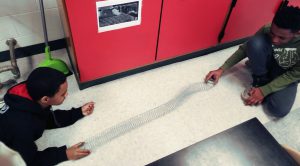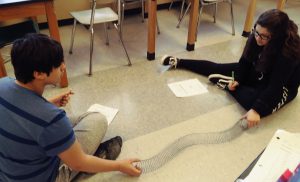You might be old enough to remember “The Slinky Song”:
“It’s Slinky; it’s Slinky.
“For fun it’s a wonderful toy.”
 And, Slinkys have a definite place definite place in the science classroom, making “for science it’s a wonderful toy.”
And, Slinkys have a definite place definite place in the science classroom, making “for science it’s a wonderful toy.”
Using common Slinkys, students in Rebecca Foster-Faith’s eighth-grade physical science students recently studied the behavior of wave energy.
Slinkys are toys in the form of a loose metal (originally) or plastic spring that can be made to “walk” down stairs as its coils separate and close up.
But, Slinkys can also be used to model all kinds of waves — a movement of motion — and provide a great STEM learning opportunity in the classroom.
 “Slinkys can be used to model transverse waves, such as light energy; and longitudinal waves, such as sound energy,” said Mrs. Foster-Faith. “By changing the frequency of the wave vibration, students can see the effect on the wavelength. By changing how much energy they put into the wave, they can see the effect on amplitude.”
“Slinkys can be used to model transverse waves, such as light energy; and longitudinal waves, such as sound energy,” said Mrs. Foster-Faith. “By changing the frequency of the wave vibration, students can see the effect on the wavelength. By changing how much energy they put into the wave, they can see the effect on amplitude.”
Transverse waves are moving waves that consists of oscillations occurring perpendicular to the direction of energy transfer. Longitudinal waves are waves in which the displacement of the medium is in the same direction as, or the opposite direction to, the direction of propagation of the wave.
Hands-on learning is a hallmark of science education and using simple tools can help explain complex processes.
“These toys are important tools that allow students to model and visualize wave behavior that explains so much of how light and sound act in our environment,” she added.
The revised New York State Science Learning Standards emphasize using hands-on investigations as a tool for teaching and learning, and using Slinkys are a perfect hands-on and fun opportunity!
